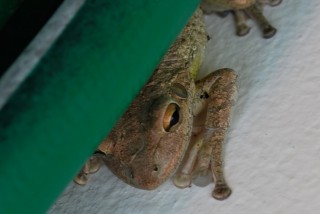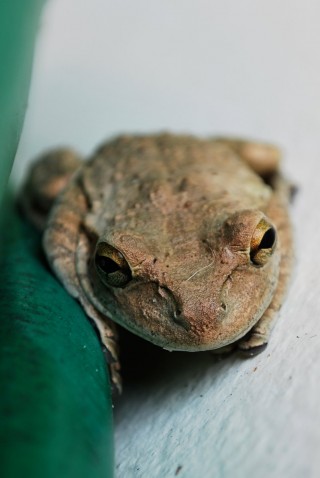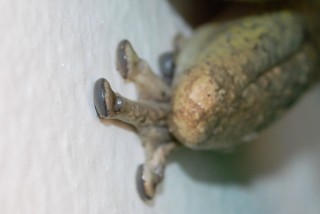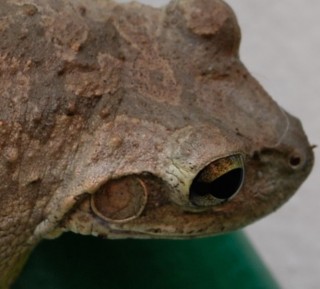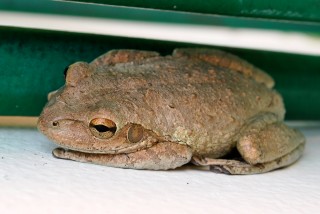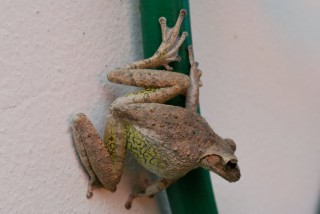Introduced species play conspicuous roles in any ecosystem, particularly here in south Florida, the gateway to the Caribbean and most of Latin America. Every few years we hear of the potential for ecological harm posed by the latest introduction, either those that have escaped from captivity, like the walking catfish, Burmese python, or Purple Swamphen; the Everglades ecosystem is still threatened by the intentional introductions of invasive plant species like melaleuca and Brazilian Pepper.
Another widespread exotic species in Florida is Osteopilus septentrionalis, the Cuban Treefrog. It’s the largest treefrog in North America by far, and it’s considered an invasive species here. According to the USGS fact sheet on this species,
Osteopilus septentrionalis is usually introduced through horticultural shipments and plantings (especially palm trees) (Meshaka, 1996a, b, 2001; Jackson in Meshaka, 1996a; Livo et al., 1998; Mitchell, 1999; Owen et al., 2006; Enge et al. 2008), building materials (Meshaka, 1996b; Dodd and Griffey, 2002; Owen et al., 2005, 2006), and motorized vehicles (Meshaka, 1996a; Enge et al. 2008). In addition to anthropogenic dispersal, it also is possible that they can disperse throughout much of the Caribbean by rafting on floating vegetation (Meshaka, 2001). Several authors have suggested that indigenous Cuban treefrogs may have existed on Key West and the lower Florida Keys since pre-Colombian times (Lazell, 1989; Meshaka, 2001). [All references are at the aforelinked fact sheet]
However they first got here, they certainly feel at home now. (By the way, most experts classify this frog, despite its cubacentric name, as a West Indian species, because it is widely distributed in the islands. It doesn’t have to worry about the wet foot/dry foot policy…) When I came home from work yesterday, M and little e greeted me with the news that one of these alien invaders could be seen at our garden hose, and sure enough, this little guy seemed quite at home there:
They don’t worry about whether they’re supposed to be here or not; they just go on about the business of being a treefrog. Of course, since they’re larger than other treefrogs, and they are frogs, which eat just about anything they can fit in their mouths, the success of the Cuban treefrog has come at the expense of our native frogs, through outright predation and competition for food and breeding resources.
Despite the fact that they are competitors of some of our dwindling populations of native treefrogs, they are still quite interesting little (and not-so-little) creatures, squawking away now and then of a wet evening, calling their call (a fairly raucous scraaaack that sounds a little bit like the call of the Southern leopard frog, except that it’s usually just one note, not several short ones in a row like Rana sphenocephala), looking for love. Dorcas & Gibbons (2008) describe it thusly:
The advertisement call sounds like a rasping version of a cross between an eastern spadefoot toad’s incessant qwaah and a southern leopard frog’s “rubbed balloon” croak.
It’s easy to tell adults of this species from just about any other treefrog on account of their size: they’re almost twice as large as our native species, up to 6 inches in the largest females. It’s hard to tell size from a photograph, and if you don’t have a native treefrog handy to compare, or you’re looking at a small individual, you need to focus on other identifying characteristics. Elliott, Gerhardt, & Davidson (2009) say that you can distinguish smaller individuals from other Florida treefrogs “by its lack of stripes and other markings running from the front of the eye to the rear and sides of the body” (120). They also note that “individuals can change color rapidly, usually from some shade of brown or tan to pale green (or vice versa), and spots may appear or disappear” (120).
Another way you can tell them apart, according to my Dorcas & Gibbons, is by the size of the toepad: it’s “disproportionately larger than those of any other southeastern frog” (103):
Yet another way you can distinguish them from our native treefrogs is their skin: they are usually pretty lumpy bumpy, while our native treefrogs look quite a bit sleeker. Furthermore, according to my Ashton & Ashton (1988), “There is a fold of skin from the eye over the tympanum and ending on the shoulder” (177). You can see it pretty clearly in this detail:
Cuban treefrogs, at least in my experience, are also pretty blase about being approached; they seem much less shy than, for example, the still unidentified critters I saw at Lake Ida ten days ago. (This could be a sign of how successful they are as a competitor; they don’t fear much, perhaps because they don’t have much to fear?)
This is not to say that they are entirely fearless; this individual eventually tired of all the attention s/he was getting from my camera, and decided to head for greener pastures. As it got going, though, it revealed its signature markings, the wash of color on the sides and back of the legs in this shot:
We’re supposed to euthanize these guys whenever we find them around, but they’re so well established, and the process is such a pain, I never can find it in my heart to do that. So this guy went on his merry, and I went about my business. Cheers!
If you’re curious, here are the instructions from UF/IFAS on how to euthanize a frog:
To euthanize a Cuban Treefrog, hold the frog firmly in your hand and apply a 1 inch bead of benzocaine ointment along the back of the frog. Benzocaine ointment is a topical anesthetic (a numbing agent) used to treat skin pain (e.g., from sunburn) and itching as well as toothaches and sore throats. There are a variety of name brand and generic versions that are available over-the-counter in a tube or spray. If you are able to, using a gloved finger spread the ointment out on the frog’s back. Alternatively, you could use a benzocaine spray. Once the ointment or spray is applied, place the frog in a plastic grocery bag or a sealable sandwich bag for 15-20 minutes so that the benzocaine has a chance to render the frog unconscious (be sure to seal the bag or tie it closed). After the bezocaine has anesthetized the frog, place the bag in a freezer overnight to ensure that the frog is dead and then throw it out in your trash. If you are unable to apply benzocaine to the frog, you can simply put it in a plastic bag, seal or tie the bag shut, then place it in the freezer overnight–dispose of the bag and the frog in the trash the next day. Do not throw a bagged frog into the trash without euthanizing it first. Remember, Cuban Treefrogs have a noxious skin secretion so be sure to wash your hands thoroughly after you handle the frog, even if you wear gloves or use a plastic bag.
Freezing is a humane way to kill amphibians because their bodies go into a state of torpor (metabolism slows way down) — just as they do in cold weather outside. If the cold weather is short in duration, the frogs will come out of their torpor state. However, after an extended time in freezing temperatures, the frogs die.
A good test to determine if a frog is a Cuban treefrog is to grasp the frog firmly, but gently, and try to move the skin around on the top of the frog’s head with your fingertip. The skin on the head of a Cuban treefrog is fused to the top of the skull and won’t move.
Be sure to wash your hands after handling any frog or toad. They all secrete a slimy film to protect their skin, but the secretions of some species, like the Cuban treefrog, can irritate the skin and eyes of some people.

